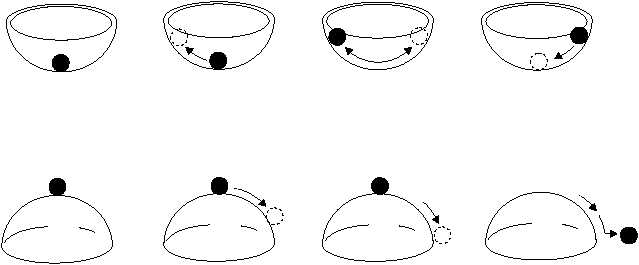Types of Stability
In figure 2-9 a bowl is set on a flat surface with a
ball placed inside it. The ball rests in the bottom of the
bowl; but, if you push the ball in any direction, it seeks
out the bottom of the bowl again. This is referred to as
ABSOLUTE STABILITY (A in fig. 2-9). Turn the
bowl upside down, position the ball anywhere on the
bowl’s bottom surface (B in fig. 2-9) and the ball starts
moving on its own without any other force being
applied. This is a condition of ABSOLUTE
INSTABILITY. If you now remove the bowl and place
the ball on the flat surface (C in fig. 2-9), you have
NEUTRAL STABILITY—that is, if a force is applied
to the ball, it moves; but if the force is removed, the ball
stops.
Air in the atmosphere reacts in a similar manner
when moved up or down. If it is moved up and becomes
denser than the surrounding air, it returns to its original
position and is considered STABLE. If it becomes less
dense than the surrounding air, it continues to rise and is
considered UNSTABLE. When density remains the
same as the surrounding air after being lifted, it is
considered NEUTRALLY STABLE, with no tendency
to rise or sink.
Equilibrium of Dry Air
The method used for determining the equilibrium
of air is the parcel method, wherein a parcel of air is
lifted and then compared with the surrounding air to
determine its equilibrium. The dry adiabatic lapse rate
is always used as a reference to determine the stability
or instability of dry air (the parcel).
ABSOLUTE
INSTABILITY.—Consider
a
column of air in which the actual lapse rate is greater
than the dry adiabatic lapse rate. The actual lapse rate is
to the left of the dry adiabatic lapse rate on the Skew-T
diagram (fig. 2-10). If the parcel of air at point A is
displaced upward to point B, it cools at the dry
adiabatic lapse rate. Upon arriving at point B, it is
warmer than the surrounding air. The parcel therefore
2-16
AG5f0209
BALL IN BOWL
FORCE MOVES BALL
DISPLACED BALL OSCILLATES
(A) ABSOLUTE STABILITY
(C) NEUTRAL STABILITY
(B) ABSOLUTE INSTABILITY
BALL BALANCED ON BOWL
RELEASE OF FORCE
PERMITS BALL TO MOVE
BALL CONTINUES
TO MOVE
BALL WILL CONTINUE
TO MOVE
BALL RESTING ON TABLE
FORCE MOVES BALL
FORCE REMOVED,
BALL STOPS
BALL REMAINS IN
NEW POSITION
BALL EVENTUALLY
RETURNS TO ORIGINAL
POSITION
Figure 2-9.—Analogy depiction of stability.


